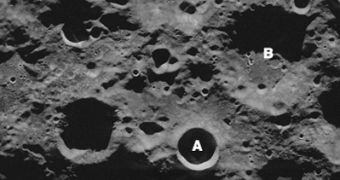Since the 1960s, there have been speculations that ice deposits might exist inside the craters on the dark side of the Moon where temperatures never exceed -173 degrees Celsius (-280 degrees Fahrenheit). These ideas became quite popular since 1992 when Earth-based radar telescopes had found such ice deposits in the craters on the dark side of Mercury (the first planet from the Sun). Moreover, the Lunar Prospector orbiter has discovered signs of hydrogen near the Moon's poles. But the question remains whether this hydrogen is part of water molecules or not.
The Moon has a dark side because near its South Pole, the sun barely edges above the horizon even during the lunar summer. However, due to the tilt of the moon's orbital plane relative to the Earth's equatorial plane, the Earth can rise much higher above the horizon (as seen from the lunar South Pole) than the Sun. This allows us to peek at some of the shadowed area. But as that area is permanently in shadow, only radar can image the terrain - i.e. we have to illuminate the region ourselves and watch the reflected (radar) light.
Following the success with Mercury, similar attempts were made since the 1990s to discover water ice deposits on the Moon. Such deposits would be necessity for any lunar base because otherwise, it is virtually impossible in the foreseeable future to carry all the needed water from Earth. Many of the instruments on NASA's 2008 Lunar Reconnaissance Orbiter/Lunar Crater Observation and Sensing Satellite mission are designed to look for water ice in permanently shadowed craters.
In April 2005, scientists had used the Arecibo Observatory in Puerto Rico to transmit a radar signal with a wavelength of 13 cm and captured the reflection from the Moon with the Robert C. Byrd Green Bank Telescope in West Virginia. They obtained an image of the South Pole with a resolution of 20 meters, the highest resolution radar image ever made of the Moon.
The radar image shown here is about 250 km by 100 km. Shackleton crater (A) is 19 km in diameter. The Lunar Prospector orbiter impacted Shoemaker crater (B), 51 km in diameter. The South Pole is about on the center of the left rim of Shackleton.
Researchers have now reported in Nature that no signs of water ice have been found, just rocks. "These new results do not preclude ice being present as small grains in the lunar soil based on the Lunar Prospector's discovery of enhanced hydrogen concentrations at the lunar poles," said Donald Campbell, Cornell professor of astronomy and a principal investigator. "There is always the possibility that concentrated deposits exist in a few of the shadowed locations not visible to radars on Earth, but any current planning for landers or bases at the lunar poles should not count on this."

 14 DAY TRIAL //
14 DAY TRIAL //